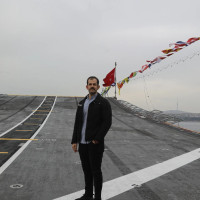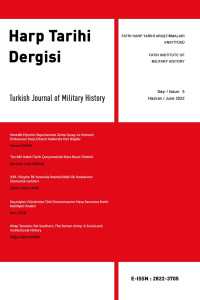Book Review
Research Article
Aim & Scope
Turkish Journal of Military History aims to make a visionary contribution to military history researches in Türkiye, publish new types of studies and become an academic focal point for experience and field-based studies regarding military history.
Turkish Journal of Military History accepts Turkish and English articles related to military history, history of warfare, weapon culture, military biography, history of military organization, military culture, military theories, history of military music, history of medicine, military architecture and military art history. All military history publications about any region of the World are to be evaluated without any regional distinction.
Author Guidelines
Ethical Principles and Publication Policy
Articles submitted to Turkish Journal of Military History shall not be previously published and shall be authentic in a way that it will contribute to the literature of the relevant field. Articles, which are descriptive expect for the stated parameters in the “Publication Ethics and Evaluation Process” or which are repetitive in their field, will not be taken into evaluation. Articles based on presentations submitted in scientific meetings may be accepted for evaluation, provided that they have not been published in the proceedings of the meetings and that the authors inform the editors so. The ethics policies and submission guidelines are written by taking into account the guidelines and policies of the Committee on Publications Ethics (COPE). More information on publication principles, relations with authors and relations with referees is stated under the relevant subheadings on the website of our Journal. If the article submitted to the Journal’s e-mail address complies with the formatting principles presented below and is found to be eligible in terms of subject/field, it is sent to (at least two) referees who are experts in the field. The Authors may re-submit their articles revised according to the reports of peer-reviewers or editors. If the article is considered to be ill-revised, it is rejected and the process is over. If the article is considered to be revised properly, it is taken as a newly submitted article into the process. Authors, who send articles in a foreign language to the Journal, are obliged to get their work proofread by a native speaker academic who is considered as an expert in their field and to provide an evidence of this proofreading. The proofreading process may also be carried out by the editors of the Journal by out-sourcing a native speaker, provided that the payment for proof-reading is paid by the author. Opinions expressed in the articles published in the Journal are the personal scientific evaluations of the authors and are not, in any way, the institutional views or opinions of their own organizations/institutes or the Fatih Institute of Military History or Turkish National Defence University. The authors whose articles have been published in Turkish Journal of Military History are considered as natural peer-reviewers of the Journal and they are obliged to perform a peer-review at least once upon the request of the Editors.
Price Policy
Makale gönderim/yayım süreçleri ücretsizdir.
Journal Boards
Baş Editör
Editör

Editör Yardımcıları


İngilizce Dil Editörü

Alan Editörleri





1984 yılında Atatürk Üniversitesi Kâzım Karabekir Eğitim Fakültesi’nden mezun oldu. 1985 yılında Marmara Üniversitesi Fen-Edebiyat Fakültesi’nde Araştırma Görevlisi olarak çalışmaya başladı. 1991 yılında doktorasını tamamlayan H. Harun Duman 1995-1996 yıllarında ABD bulunan Columbia Üniversitesi’nde misafir öğretim üyesi olarak çalıştı. 1997 yılında doçent olan yazar 2002-2004 yılları arasında KKTC’de bulunan Doğu Akdeniz Üniversitesi Fen-Edebiyat Fakültesi’nde, 2005-2007 yılları arasında İstanbul Ticaret Üniversitesi’nde misafir öğretim üyesi olarak görev yaptı. 2008-2010 yılları arasında M.Ü. Fen-Edebiyat Fakültesi’nde Dekan Yardımcılığı yapan Prof. Duman, 2010 yılından bu yana M.Ü. Yabancı Diller Yüksekokul Müdürlüğü görevini yürütmektedir. Modern Türk Edebiyatı, Türk Basın Tarihi, Anı Kitapları, Metin Çözümlemeleri, Mizah Edebiyatı, Senaryo Yazımı vb. gibi konularda çok sayıda makale ve kitapları bulunmakta, profesyonel yayıncı olarak çalışmalarını sürdürmektedir.
Yazarın Diğer Kitapları
Erzurum Basın-Yayın Tarihi, İstanbul: DUYAP Yayıncılık, 2005
Erzurum Fıkraları ve Meşhur Nüktedanar, İstanbul: DUYAP Yayıncılık, 2005
Gülen Dadaş, İstanbul: DUYAP Yayıncılık, 2005
Balkanlara Veda, İstanbul: DUYAP Yayıncılık, 2005
Metin Çözümleme Yöntemleri: Tanzimat Dönemi, İstanbul: DUYAP Yayıncılık, 2005
Hemşin’den Amerika’ya Ali Ertuğrulun Anıları, İstanbul: Sade Yayıncılık, 2010
Türk Basın Tarihi, Eskişehir: Anadolu Üniversitesi Yayınları, 2. Bs., 2016
Şinasi’nin Şiir Dünyası, İstanbul: DUYAP Yayıncılık, 2016
Unutulmayan Ahıska, (Furkan Abir-Hiranur Baylan Aslan-Elif Buse Ay-Melike Selcan Batır-Derya Çetin), İistanbul: DUYAP Yayınları, 2023.
Kars Anıları (1960-1985), İstanbul: DUYAP Yayınları, 2023
Erzurum’a Selam Söyle, İstanbul: DUYAP Yayınları, 2024
Erzurum’un Antika İnsanları ve Mahalle Kültürü, İstanbul: DUYAP Yayınları, 2024.
Boğaziçi'nin Şiiri, İstanbul: DUYAP Yayınları, 2025.
Çağdaş Edebiyat Kavram ve Kuramları, DUYAP Yayınları, 2025.
Açıklamalı Anılar Ansiklopedisi, DUYAP Yayınları, 2025.
Türkiye Coğrafyası Anabilim Dalı öğretim üyesi olan Şahin; Türkiye nüfusu, nüfus politikaları, göç ve yer adları konularında akademik çalışmalar yaptı. Bu alanlarda lisans ve lisansüstü dersler yanında çok sayıda konferans verdi.
İstanbul'un nüfus özellikleri konusunda çalışmaları bulunan Şahin, İstanbul’un aldığı göçler konusunda çeşitli çalışmalar yaptı. Bu kapsamda; Erzurum, Tokat, Giresun ve Denizli’den İstanbul’a olan göçler konusunda yayınları oldu. Ayrıca coğrafya ve mekan ilişkisi kapsamında, Cumhuriyet Dönemi İstanbul’un mekânsal gelişimi konusunda çalışmalar yaptı.
Milli Eğitim Bakanlığı Coğrafya 10. Sınıf (2017-2018), Coğrafya 12. Sınıf (2017- 2022) ve Coğrafya 11. Sınıf (2024-2025) lise coğrafya ders kitaplarının editörlüğünü yaptı.
Marmara Üniversitesi'ndeki görevi yanında, 2011 ve 2012 yıllarında KKTC Yakın Doğu Üniversitesi'nde çeşitli dersler verdi.
Şahin, 2018-2021 yılları arasında Atatürk Kültür Dil Tarih Yüksek Kurumu Atatürk Kültür Merkezi Başkanlığı Bilim Kurulu asli üyelisi olarak görev yaptı.
Akademik dergi ve sempozyumlarda editörlük, bilim, yayın ve düzenleme kurulu üyeliği yaptı. Akademik faaliyetler yanında enstitü müdürlüğü, dekan yardımcılığı gibi idari görevlerde bulundu.
Şahin, halen Milli Savunma Üniversitesi Deniz Harp Okulu Dekanı olarak görev yapmaktadır.
Yayın Kurulu

M. Fatih Çalışır specializes in early modern Ottoman history and environmental history. He received his BA from Fatih University in 2005, his MA from Bilkent University in 2009, and his Ph.D. from Georgetown University in 2016. Before beginning his doctoral studies, Çalışır served as an assistant specialist at the Turkish Ministry of Culture and Tourism, where he contributed to cultural heritage preservation efforts at the Topkapı Palace Manuscripts Library and the Istanbul Museum of the History of Islamic Science and Technology (2009–2010). Throughout his academic career, Çalışır has held several positions. From 2017 to 2019, he was affiliated with Ibn Haldun University, and from 2019 to 2023, he served as a faculty member in the Department of History at Kırklareli University. In 2024 and 2025, he was a visiting researcher at the Harvard University Center for Middle Eastern Studies, supported by the TÜBİTAK 2219 Postdoctoral Research Fellowship Abroad. Since February 2023, he has been a full-time faculty member at the Institute of Islamic Studies at Istanbul University.
Çalışır is the author of a monograph on Mehmed I and has edited several scholarly volumes, including works on the Köprülü years in Ottoman history (1656–1710), the era of Suleiman the Lawgiver (with Suraiya Faroqhi and M. Şakir Yılmaz), and the history of the Turkish war industry (with A. Sefa Özkaya). He is also recognized for his translations of academic studies on environmental history, military history, and the Baburid Empire from English into Turkish. In addition to his publications, Çalışır is the founder of the Bilkent History Society and the Environmental History Society of Turkey. He also spearheaded the biennial Süleymaniye International Symposium, which has fostered scholarly exchange and collaboration in the field of history.


Dr.Öğr.Üyesi Zekeriya Türkmen
6 Mayıs 1964 tarihinde Bursa-Karacabey’de doğdu. İlköğrenimini Karacabey’de, ortaöğrenimini Sakarya Arifiye Öğretmen Lisesinde tamamladı. 23 Haziran 1986 tarihinde İstanbul Üniversitesi Edebiyat Fakültesi Tarih Bölümü ile İstanbul F.Y.O.’dan Öğretmen Teğmen olarak mezun oldu. Marmara Üniversitesi Sosyal Bilimler Enstitüsünde Yakınçağ Tarihi Anabilim dalı yüksek lisans programından (1990), aynı üniversitenin Türkiyat Araştırmaları Enstitüsü Yakınçağ Tarihi doktora programından (1996) mezun olduktan sonra uzun yıllar T.S.K.’ya bağlı eğitim kurumlarında (Elektronik Astsb. Hazırlama Okulu, Kuleli Askeri Lisesi, Genelkurmay Askeri Tarih ve Stratejik Etüt Başkanlığı, Kara Harp Okulu, Harp Akademileri, Harbiye Askeri Müze ve Kültür Sitesi Müzecilik Grup Başkanlığı, Milli Savunma Üniversitesi, Atatürk Stratejik Araştırmalar Enstitüsü ve Kuvvet Harp Enstitüleri) ve üniversitelerde (Hacettepe Ünv. Beykent, İstanbul 29 Mayıs Üniversitesi) Öğretmen, Öğretim Görevlisi/Üyesi, Bölüm Başkanı, Enstitü Müdürü, vd kadrolarda görev yaptı (1986-2016). 30 Ağustos 2016’da, 30 küsur yıllık hizmetten sonra T.S.K.dan Öğretmen Kıdemli Albay rütbesinden kadrosuzluk sebebiyle emekli oldu.
Çalışmalarını Yakınçağ Tarihi üzerine yoğunlaştırdı. Yakınçağ Osmanlı Tarihi, Osmanlı Askerî Teşkilat Tarihi, XIX-XX. Yüzyıl Siyasî Tarihi, Meşrutiyet Dönemi, Kurtuluş Savaşı, Cumhuriyet Tarihi ve Atatürk dönemi konularında çalışmalar yaptı. 2016 yılı itibariyle yayımlanmış 20 müstakil, 25 ortak yazarlı kitabı, ulusal/uluslararası akademik dergilerde ve bilimsel etkinliklerde sunulup yayımlanmış 120'nin üzerinde makale ve bildirisi bulunmaktadır. TRT ve özel radyo - tv.leri ile özel yayın kuruluşları için tarihî konularda hazırladığı senaryo metinleri ve belgeselleri yayımlanmıştır. Anıtkabir Atatürk ve Kurtuluş Savaşı Müzesinin hazırlanmasında Tarih ve Sanat Danışma Kurulu Başkanı olarak, Kurtuluş Savaşı Malıköy Tren İstasyonu Müzesi, Polatlı Mehmetçik ve Duatepe Anıtı, Makedonya Manastır Askerî İdadisi Atatürk Anı Odası, Makedonya Debre-i Bâlâ Atatürk Ata Evi, İstanbul'da Harbiye Askerî Müzesinde Türk Tarihiyle ilgili Panorama ve Diaramaların hazırlanması, Polatlı Kartaltepe Sakarya Meydan Muharebesi ve Türk Tarihi Tanıtım Merkezinin hazırlanması çalışmalarında görev alarak katkıda bulunmuştur. Almanya Türk-Unid ve Türk Askeri Tarih Komisyonu üyesi olan Dr. Türkmen, halen İstanbul 29 Mayıs Üniversitesi Edebiyat Fakültesi Tarih Bölümünde görev yapmakta olup, M.S.Ü. ATASAREN ve Kuvvet Harp Enstitülerinde alanıyla ilgili dersler vermektedir.
SHORT BIOGRAPHY
Birth place- Alpan (Guba), Azerbaijan; birth date-1965; marital status-married, two kids.
EDUCATION, SCIENTIFIC DEGREE AND SCIENTIFIC NAMES
• 1972-1982 – the high school, Alpan (Guba)
• 1988-1993 –Taras Shevchenko National University of Kyiv, faculty of History
• 1994-1997 – post-graduate study, Baku State University
• 2000 – Defense the thesis on the theme of “Russians business activity in Azerbaijan during the second half of XIX and beginning of XX centuries”
• May 2001 – Academic degree PhD on History, approved by the Supreme Attestation Commission attached to the President of the Republic of Azerbaijan
WORK EXPERIENCE
• 1995 – High school No 245, History teacher
• 1996-2008 – Baku Eurasian University (former Higher Diplomatic College, Baku Diplomacy University) Director of External Relations Department, Head of the Department, the Dean Assistant, the Dean, Vice President,
• 2008- up to present, Associated Professor, Azerbaijan University of Languages, Azerbaijan National Defense University
Danışma Kurulu

22 Ocak 1968’de Trabzon’da doğdu. İlk, orta ve lise öğrenimini aynı vilayette tamamladıktan sonra, 1985 yılında Atatürk Üniversitesi, Fen-Edebiyat Fakültesi Tarih Bölümü’nde yüksek öğrenimine başladı. Tarih bölümünü Haziran 1989’da birincilikle bitirdi. Aynı Üniversitede, yüksek lisans ve doktora eğitimi aldı. 1990 yılında Atatürk Üniversitesi, Atatürk İlkeleri ve İnkılap Tarihi Ensitüsü’nde araştırma görevlisi oldu. 1991 yılında “İstanbul Basınında Vilâyât-ı Şarkiye Meselesi” adlı master teziyle yüksek lisansını, 1996 yılında da “Türkiye ve Mavera-yı Kafkasya İlişkileri İçerisinde Trabzon ve Batum Konferansları ve Antlaşmaları (1917-1918)” adlı çalışmayla doktorasını tamamladı. 2 Ağustos 1996 tarihinde Sakarya Üniversitesi, Tarih Bölümü’ne öğretim üyesi olarak atandı ve halen aynı üniversitede çalışmaya devam etmektedir. California’da bulunan Stanford Üniversitesi başta olmak üzere, yurtdışındaki çeşitli üniversitelerde kısa ve uzun sürelerle “misafir öğretim üyesi” olarak bulundu. 2006’da doçentliğe, Temmuz 2011’de ise Türkiye Cumhuriyeti Tarihi anabilim dalında profesörlüğe yükseltildi. Ağustos 2009-Ağustos 2014 tarihleri arasında Türk Tarih Kurumu bünyesindeki Ermeni Masası’nda çalıştı. Yazar halen Sakarya Üniversitesi’nde öğretim üyesi olarak çalışmaya devam etmekte, ilgi alanları, Atatürk ve Cumhuriyet Tarihimizin çeşitli evrelerine ait lisans ve lisansüstü seviyede dersler vermektedir. Evli olan Prof.Dr. Şahin’in, iki yüzden fazla makale, bildiri, editörlük, yayına hazırlama, ansiklopedi maddesi, kitap bölümü ve kitapları bulunmaktadır.










